Employee Motivation: An Analysis of Motivational Theories at Work
VerifiedAdded on 2023/06/10
|8
|1984
|253
Essay
AI Summary
This essay delves into the critical topic of employee motivation, examining two prominent theories: Maslow's hierarchy of needs and McClelland's theory of needs. The introduction defines employee motivation and its significance for organizational growth, highlighting the role of job satisfaction and working environment. The main body provides a detailed analysis of both theories, explaining their core concepts and practical applications in the workplace. Maslow's theory is presented with its five hierarchical needs – physiological, safety, love and belonging, esteem, and self-actualization – and how they can be fulfilled in a work setting. The essay also discusses the advantages and disadvantages of applying this theory. McClelland's theory, focusing on the needs for achievement, power, and affiliation, is then explored, including how managers can identify and address these needs to enhance employee motivation. The advantages and disadvantages of McClelland’s theory are also included. The conclusion summarizes the key findings, emphasizing the importance of selecting the most suitable motivational theory based on specific workplace requirements, to improve employee motivation.

Essay
1
1
Paraphrase This Document
Need a fresh take? Get an instant paraphrase of this document with our AI Paraphraser
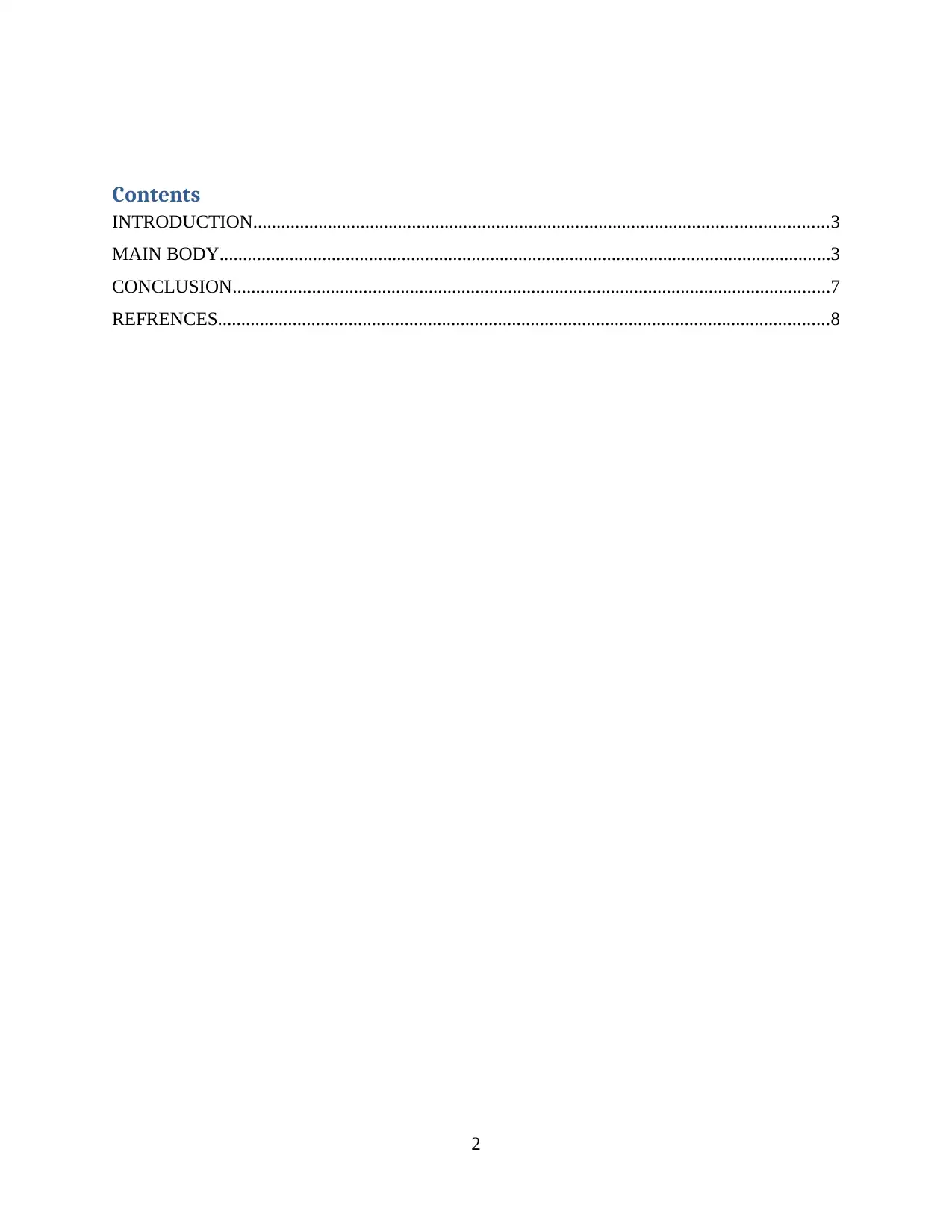
Contents
INTRODUCTION...........................................................................................................................3
MAIN BODY...................................................................................................................................3
CONCLUSION................................................................................................................................7
REFRENCES...................................................................................................................................8
2
INTRODUCTION...........................................................................................................................3
MAIN BODY...................................................................................................................................3
CONCLUSION................................................................................................................................7
REFRENCES...................................................................................................................................8
2
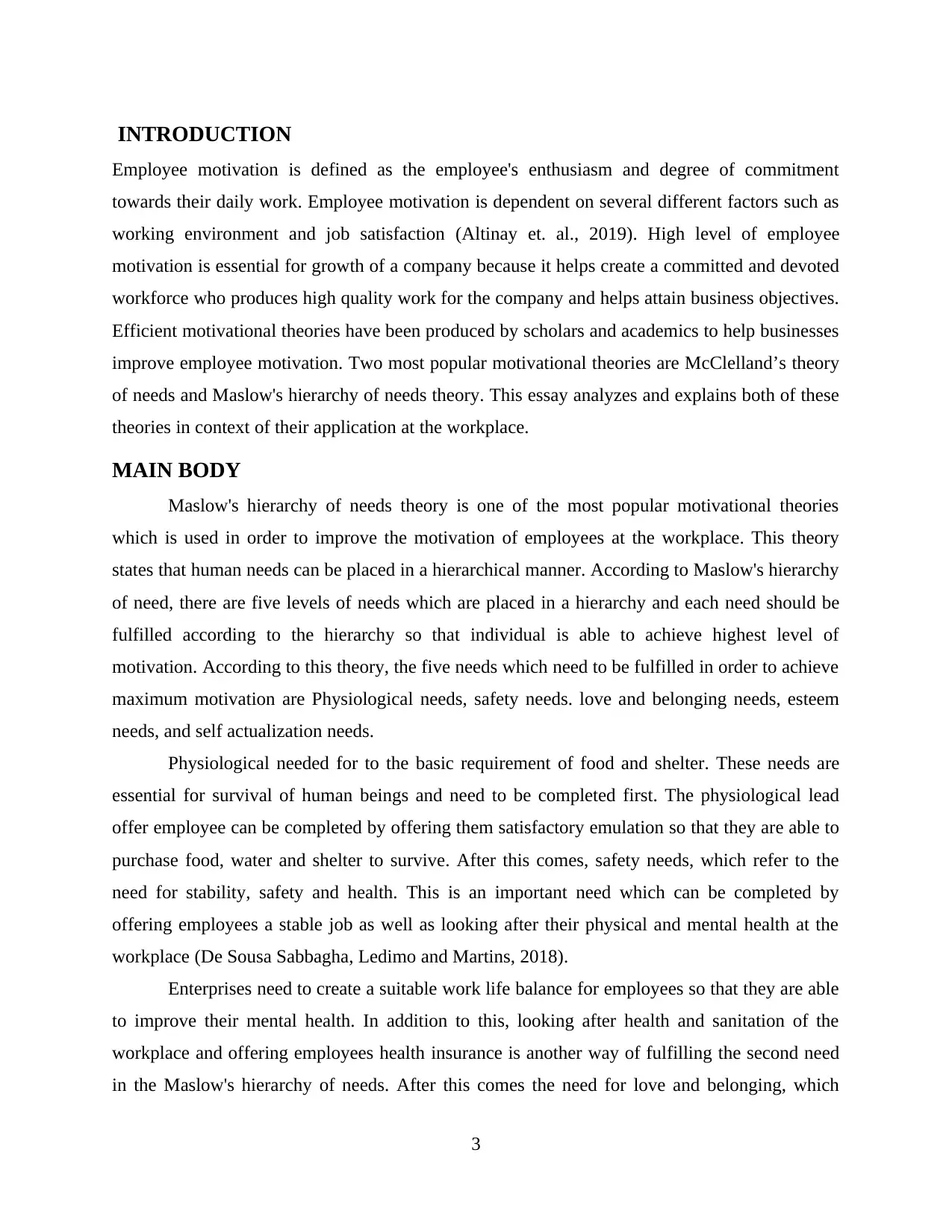
INTRODUCTION
Employee motivation is defined as the employee's enthusiasm and degree of commitment
towards their daily work. Employee motivation is dependent on several different factors such as
working environment and job satisfaction (Altinay et. al., 2019). High level of employee
motivation is essential for growth of a company because it helps create a committed and devoted
workforce who produces high quality work for the company and helps attain business objectives.
Efficient motivational theories have been produced by scholars and academics to help businesses
improve employee motivation. Two most popular motivational theories are McClelland’s theory
of needs and Maslow's hierarchy of needs theory. This essay analyzes and explains both of these
theories in context of their application at the workplace.
MAIN BODY
Maslow's hierarchy of needs theory is one of the most popular motivational theories
which is used in order to improve the motivation of employees at the workplace. This theory
states that human needs can be placed in a hierarchical manner. According to Maslow's hierarchy
of need, there are five levels of needs which are placed in a hierarchy and each need should be
fulfilled according to the hierarchy so that individual is able to achieve highest level of
motivation. According to this theory, the five needs which need to be fulfilled in order to achieve
maximum motivation are Physiological needs, safety needs. love and belonging needs, esteem
needs, and self actualization needs.
Physiological needed for to the basic requirement of food and shelter. These needs are
essential for survival of human beings and need to be completed first. The physiological lead
offer employee can be completed by offering them satisfactory emulation so that they are able to
purchase food, water and shelter to survive. After this comes, safety needs, which refer to the
need for stability, safety and health. This is an important need which can be completed by
offering employees a stable job as well as looking after their physical and mental health at the
workplace (De Sousa Sabbagha, Ledimo and Martins, 2018).
Enterprises need to create a suitable work life balance for employees so that they are able
to improve their mental health. In addition to this, looking after health and sanitation of the
workplace and offering employees health insurance is another way of fulfilling the second need
in the Maslow's hierarchy of needs. After this comes the need for love and belonging, which
3
Employee motivation is defined as the employee's enthusiasm and degree of commitment
towards their daily work. Employee motivation is dependent on several different factors such as
working environment and job satisfaction (Altinay et. al., 2019). High level of employee
motivation is essential for growth of a company because it helps create a committed and devoted
workforce who produces high quality work for the company and helps attain business objectives.
Efficient motivational theories have been produced by scholars and academics to help businesses
improve employee motivation. Two most popular motivational theories are McClelland’s theory
of needs and Maslow's hierarchy of needs theory. This essay analyzes and explains both of these
theories in context of their application at the workplace.
MAIN BODY
Maslow's hierarchy of needs theory is one of the most popular motivational theories
which is used in order to improve the motivation of employees at the workplace. This theory
states that human needs can be placed in a hierarchical manner. According to Maslow's hierarchy
of need, there are five levels of needs which are placed in a hierarchy and each need should be
fulfilled according to the hierarchy so that individual is able to achieve highest level of
motivation. According to this theory, the five needs which need to be fulfilled in order to achieve
maximum motivation are Physiological needs, safety needs. love and belonging needs, esteem
needs, and self actualization needs.
Physiological needed for to the basic requirement of food and shelter. These needs are
essential for survival of human beings and need to be completed first. The physiological lead
offer employee can be completed by offering them satisfactory emulation so that they are able to
purchase food, water and shelter to survive. After this comes, safety needs, which refer to the
need for stability, safety and health. This is an important need which can be completed by
offering employees a stable job as well as looking after their physical and mental health at the
workplace (De Sousa Sabbagha, Ledimo and Martins, 2018).
Enterprises need to create a suitable work life balance for employees so that they are able
to improve their mental health. In addition to this, looking after health and sanitation of the
workplace and offering employees health insurance is another way of fulfilling the second need
in the Maslow's hierarchy of needs. After this comes the need for love and belonging, which
3
⊘ This is a preview!⊘
Do you want full access?
Subscribe today to unlock all pages.

Trusted by 1+ million students worldwide
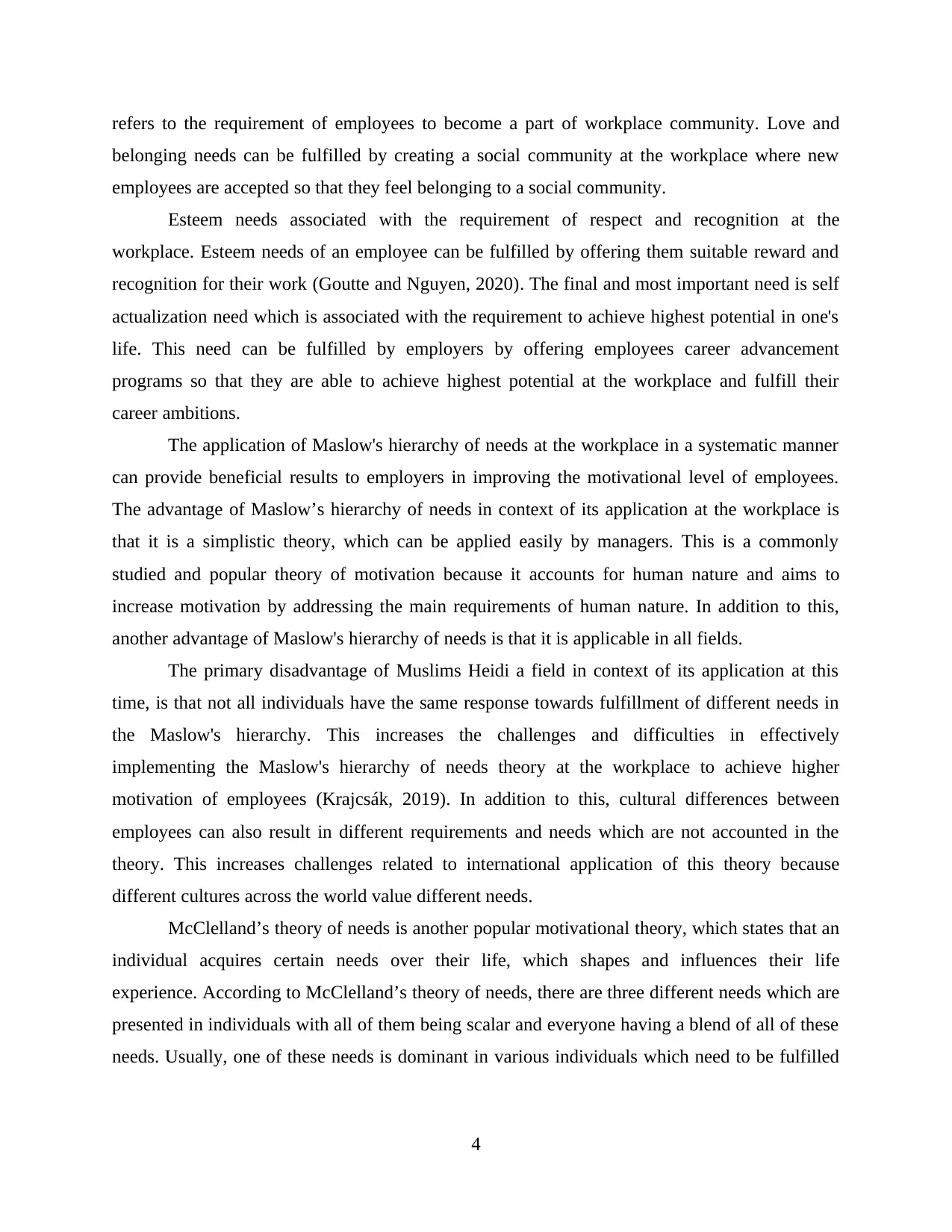
refers to the requirement of employees to become a part of workplace community. Love and
belonging needs can be fulfilled by creating a social community at the workplace where new
employees are accepted so that they feel belonging to a social community.
Esteem needs associated with the requirement of respect and recognition at the
workplace. Esteem needs of an employee can be fulfilled by offering them suitable reward and
recognition for their work (Goutte and Nguyen, 2020). The final and most important need is self
actualization need which is associated with the requirement to achieve highest potential in one's
life. This need can be fulfilled by employers by offering employees career advancement
programs so that they are able to achieve highest potential at the workplace and fulfill their
career ambitions.
The application of Maslow's hierarchy of needs at the workplace in a systematic manner
can provide beneficial results to employers in improving the motivational level of employees.
The advantage of Maslow’s hierarchy of needs in context of its application at the workplace is
that it is a simplistic theory, which can be applied easily by managers. This is a commonly
studied and popular theory of motivation because it accounts for human nature and aims to
increase motivation by addressing the main requirements of human nature. In addition to this,
another advantage of Maslow's hierarchy of needs is that it is applicable in all fields.
The primary disadvantage of Muslims Heidi a field in context of its application at this
time, is that not all individuals have the same response towards fulfillment of different needs in
the Maslow's hierarchy. This increases the challenges and difficulties in effectively
implementing the Maslow's hierarchy of needs theory at the workplace to achieve higher
motivation of employees (Krajcsák, 2019). In addition to this, cultural differences between
employees can also result in different requirements and needs which are not accounted in the
theory. This increases challenges related to international application of this theory because
different cultures across the world value different needs.
McClelland’s theory of needs is another popular motivational theory, which states that an
individual acquires certain needs over their life, which shapes and influences their life
experience. According to McClelland’s theory of needs, there are three different needs which are
presented in individuals with all of them being scalar and everyone having a blend of all of these
needs. Usually, one of these needs is dominant in various individuals which need to be fulfilled
4
belonging needs can be fulfilled by creating a social community at the workplace where new
employees are accepted so that they feel belonging to a social community.
Esteem needs associated with the requirement of respect and recognition at the
workplace. Esteem needs of an employee can be fulfilled by offering them suitable reward and
recognition for their work (Goutte and Nguyen, 2020). The final and most important need is self
actualization need which is associated with the requirement to achieve highest potential in one's
life. This need can be fulfilled by employers by offering employees career advancement
programs so that they are able to achieve highest potential at the workplace and fulfill their
career ambitions.
The application of Maslow's hierarchy of needs at the workplace in a systematic manner
can provide beneficial results to employers in improving the motivational level of employees.
The advantage of Maslow’s hierarchy of needs in context of its application at the workplace is
that it is a simplistic theory, which can be applied easily by managers. This is a commonly
studied and popular theory of motivation because it accounts for human nature and aims to
increase motivation by addressing the main requirements of human nature. In addition to this,
another advantage of Maslow's hierarchy of needs is that it is applicable in all fields.
The primary disadvantage of Muslims Heidi a field in context of its application at this
time, is that not all individuals have the same response towards fulfillment of different needs in
the Maslow's hierarchy. This increases the challenges and difficulties in effectively
implementing the Maslow's hierarchy of needs theory at the workplace to achieve higher
motivation of employees (Krajcsák, 2019). In addition to this, cultural differences between
employees can also result in different requirements and needs which are not accounted in the
theory. This increases challenges related to international application of this theory because
different cultures across the world value different needs.
McClelland’s theory of needs is another popular motivational theory, which states that an
individual acquires certain needs over their life, which shapes and influences their life
experience. According to McClelland’s theory of needs, there are three different needs which are
presented in individuals with all of them being scalar and everyone having a blend of all of these
needs. Usually, one of these needs is dominant in various individuals which need to be fulfilled
4
Paraphrase This Document
Need a fresh take? Get an instant paraphrase of this document with our AI Paraphraser
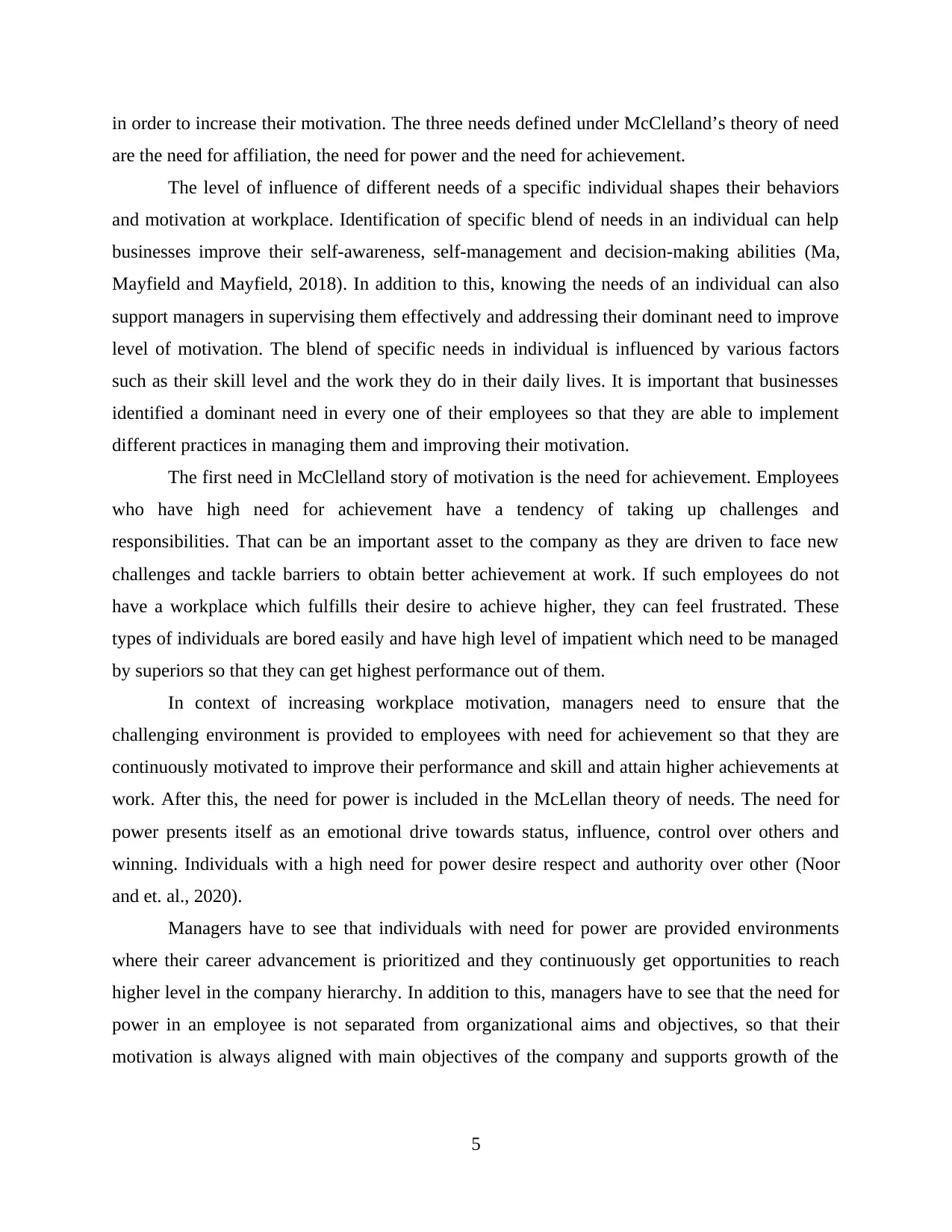
in order to increase their motivation. The three needs defined under McClelland’s theory of need
are the need for affiliation, the need for power and the need for achievement.
The level of influence of different needs of a specific individual shapes their behaviors
and motivation at workplace. Identification of specific blend of needs in an individual can help
businesses improve their self-awareness, self-management and decision-making abilities (Ma,
Mayfield and Mayfield, 2018). In addition to this, knowing the needs of an individual can also
support managers in supervising them effectively and addressing their dominant need to improve
level of motivation. The blend of specific needs in individual is influenced by various factors
such as their skill level and the work they do in their daily lives. It is important that businesses
identified a dominant need in every one of their employees so that they are able to implement
different practices in managing them and improving their motivation.
The first need in McClelland story of motivation is the need for achievement. Employees
who have high need for achievement have a tendency of taking up challenges and
responsibilities. That can be an important asset to the company as they are driven to face new
challenges and tackle barriers to obtain better achievement at work. If such employees do not
have a workplace which fulfills their desire to achieve higher, they can feel frustrated. These
types of individuals are bored easily and have high level of impatient which need to be managed
by superiors so that they can get highest performance out of them.
In context of increasing workplace motivation, managers need to ensure that the
challenging environment is provided to employees with need for achievement so that they are
continuously motivated to improve their performance and skill and attain higher achievements at
work. After this, the need for power is included in the McLellan theory of needs. The need for
power presents itself as an emotional drive towards status, influence, control over others and
winning. Individuals with a high need for power desire respect and authority over other (Noor
and et. al., 2020).
Managers have to see that individuals with need for power are provided environments
where their career advancement is prioritized and they continuously get opportunities to reach
higher level in the company hierarchy. In addition to this, managers have to see that the need for
power in an employee is not separated from organizational aims and objectives, so that their
motivation is always aligned with main objectives of the company and supports growth of the
5
are the need for affiliation, the need for power and the need for achievement.
The level of influence of different needs of a specific individual shapes their behaviors
and motivation at workplace. Identification of specific blend of needs in an individual can help
businesses improve their self-awareness, self-management and decision-making abilities (Ma,
Mayfield and Mayfield, 2018). In addition to this, knowing the needs of an individual can also
support managers in supervising them effectively and addressing their dominant need to improve
level of motivation. The blend of specific needs in individual is influenced by various factors
such as their skill level and the work they do in their daily lives. It is important that businesses
identified a dominant need in every one of their employees so that they are able to implement
different practices in managing them and improving their motivation.
The first need in McClelland story of motivation is the need for achievement. Employees
who have high need for achievement have a tendency of taking up challenges and
responsibilities. That can be an important asset to the company as they are driven to face new
challenges and tackle barriers to obtain better achievement at work. If such employees do not
have a workplace which fulfills their desire to achieve higher, they can feel frustrated. These
types of individuals are bored easily and have high level of impatient which need to be managed
by superiors so that they can get highest performance out of them.
In context of increasing workplace motivation, managers need to ensure that the
challenging environment is provided to employees with need for achievement so that they are
continuously motivated to improve their performance and skill and attain higher achievements at
work. After this, the need for power is included in the McLellan theory of needs. The need for
power presents itself as an emotional drive towards status, influence, control over others and
winning. Individuals with a high need for power desire respect and authority over other (Noor
and et. al., 2020).
Managers have to see that individuals with need for power are provided environments
where their career advancement is prioritized and they continuously get opportunities to reach
higher level in the company hierarchy. In addition to this, managers have to see that the need for
power in an employee is not separated from organizational aims and objectives, so that their
motivation is always aligned with main objectives of the company and supports growth of the
5
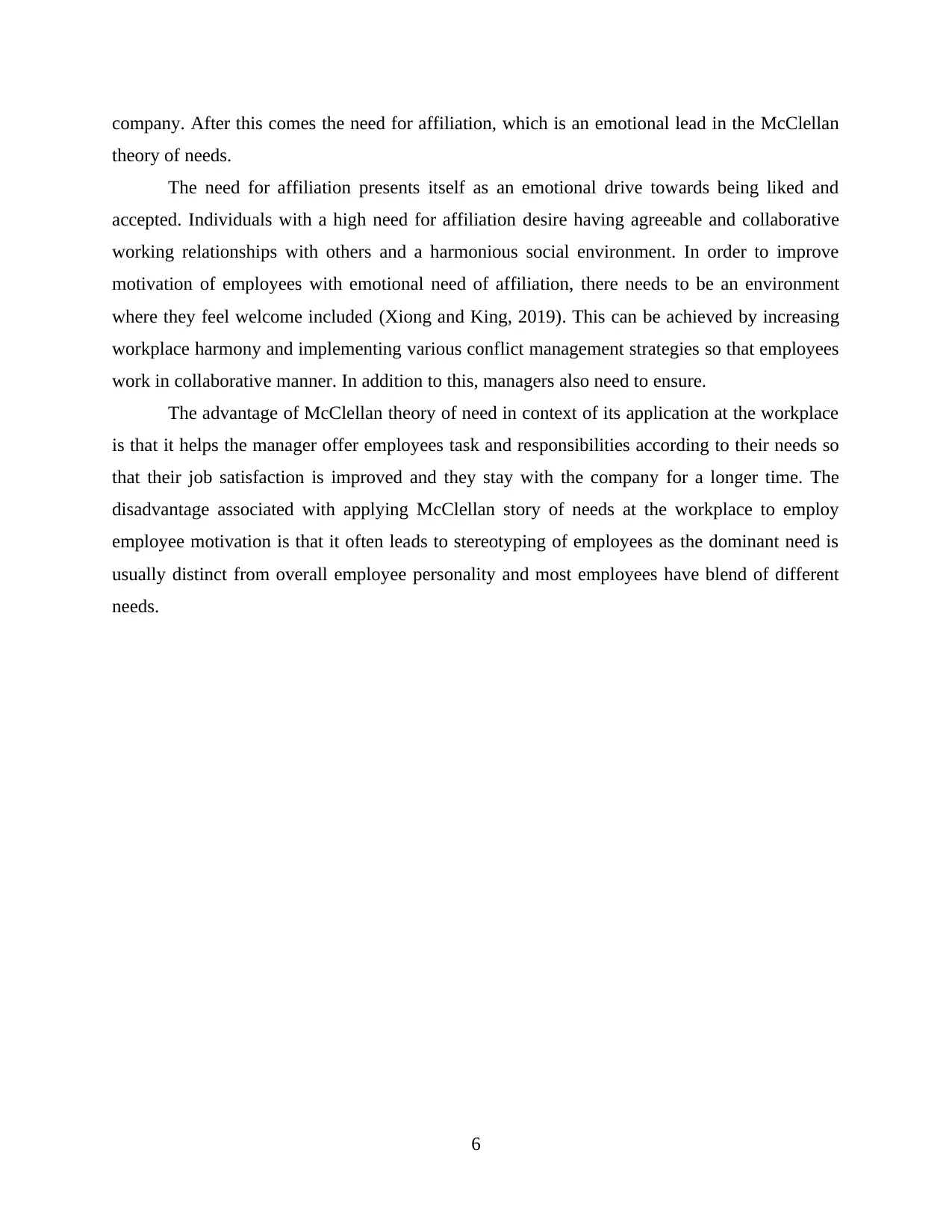
company. After this comes the need for affiliation, which is an emotional lead in the McClellan
theory of needs.
The need for affiliation presents itself as an emotional drive towards being liked and
accepted. Individuals with a high need for affiliation desire having agreeable and collaborative
working relationships with others and a harmonious social environment. In order to improve
motivation of employees with emotional need of affiliation, there needs to be an environment
where they feel welcome included (Xiong and King, 2019). This can be achieved by increasing
workplace harmony and implementing various conflict management strategies so that employees
work in collaborative manner. In addition to this, managers also need to ensure.
The advantage of McClellan theory of need in context of its application at the workplace
is that it helps the manager offer employees task and responsibilities according to their needs so
that their job satisfaction is improved and they stay with the company for a longer time. The
disadvantage associated with applying McClellan story of needs at the workplace to employ
employee motivation is that it often leads to stereotyping of employees as the dominant need is
usually distinct from overall employee personality and most employees have blend of different
needs.
6
theory of needs.
The need for affiliation presents itself as an emotional drive towards being liked and
accepted. Individuals with a high need for affiliation desire having agreeable and collaborative
working relationships with others and a harmonious social environment. In order to improve
motivation of employees with emotional need of affiliation, there needs to be an environment
where they feel welcome included (Xiong and King, 2019). This can be achieved by increasing
workplace harmony and implementing various conflict management strategies so that employees
work in collaborative manner. In addition to this, managers also need to ensure.
The advantage of McClellan theory of need in context of its application at the workplace
is that it helps the manager offer employees task and responsibilities according to their needs so
that their job satisfaction is improved and they stay with the company for a longer time. The
disadvantage associated with applying McClellan story of needs at the workplace to employ
employee motivation is that it often leads to stereotyping of employees as the dominant need is
usually distinct from overall employee personality and most employees have blend of different
needs.
6
⊘ This is a preview!⊘
Do you want full access?
Subscribe today to unlock all pages.

Trusted by 1+ million students worldwide

CONCLUSION
From the above essay, it is determined that in order to improve employee motivation, businesses
have to implement different motivational theories at the workplace. McClelland theory of needs
and Muslim's idea of needs can be used by businesses to improve employee motivation. Man's
last hierarchy of need covers basic needs which need to be fulfilled in order to reach maximum
stage of motivation. On the other hand, McClelland’s theory of needs helps identify the dominant
need of an individual shapes, their life experience to offer them tasks and working environment
suitable to their specific needs. Both of these theories of motivation have advantages and
disadvantages when applying at the workplace. It is concluded that businesses need to
understand their specific work. Please requirement in order to select the most suitable theory for
improving employee motivation.
7
From the above essay, it is determined that in order to improve employee motivation, businesses
have to implement different motivational theories at the workplace. McClelland theory of needs
and Muslim's idea of needs can be used by businesses to improve employee motivation. Man's
last hierarchy of need covers basic needs which need to be fulfilled in order to reach maximum
stage of motivation. On the other hand, McClelland’s theory of needs helps identify the dominant
need of an individual shapes, their life experience to offer them tasks and working environment
suitable to their specific needs. Both of these theories of motivation have advantages and
disadvantages when applying at the workplace. It is concluded that businesses need to
understand their specific work. Please requirement in order to select the most suitable theory for
improving employee motivation.
7
Paraphrase This Document
Need a fresh take? Get an instant paraphrase of this document with our AI Paraphraser
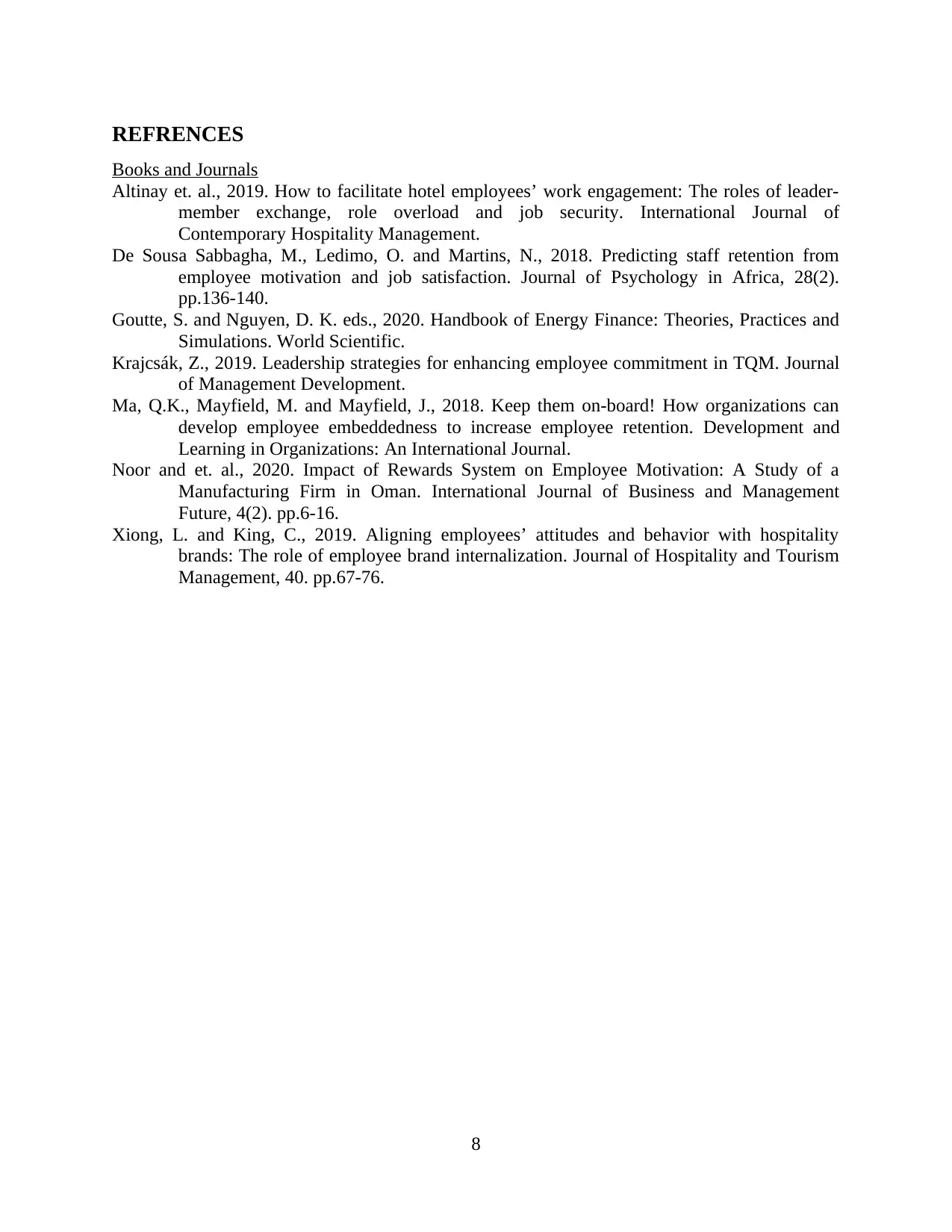
REFRENCES
Books and Journals
Altinay et. al., 2019. How to facilitate hotel employees’ work engagement: The roles of leader-
member exchange, role overload and job security. International Journal of
Contemporary Hospitality Management.
De Sousa Sabbagha, M., Ledimo, O. and Martins, N., 2018. Predicting staff retention from
employee motivation and job satisfaction. Journal of Psychology in Africa, 28(2).
pp.136-140.
Goutte, S. and Nguyen, D. K. eds., 2020. Handbook of Energy Finance: Theories, Practices and
Simulations. World Scientific.
Krajcsák, Z., 2019. Leadership strategies for enhancing employee commitment in TQM. Journal
of Management Development.
Ma, Q.K., Mayfield, M. and Mayfield, J., 2018. Keep them on-board! How organizations can
develop employee embeddedness to increase employee retention. Development and
Learning in Organizations: An International Journal.
Noor and et. al., 2020. Impact of Rewards System on Employee Motivation: A Study of a
Manufacturing Firm in Oman. International Journal of Business and Management
Future, 4(2). pp.6-16.
Xiong, L. and King, C., 2019. Aligning employees’ attitudes and behavior with hospitality
brands: The role of employee brand internalization. Journal of Hospitality and Tourism
Management, 40. pp.67-76.
8
Books and Journals
Altinay et. al., 2019. How to facilitate hotel employees’ work engagement: The roles of leader-
member exchange, role overload and job security. International Journal of
Contemporary Hospitality Management.
De Sousa Sabbagha, M., Ledimo, O. and Martins, N., 2018. Predicting staff retention from
employee motivation and job satisfaction. Journal of Psychology in Africa, 28(2).
pp.136-140.
Goutte, S. and Nguyen, D. K. eds., 2020. Handbook of Energy Finance: Theories, Practices and
Simulations. World Scientific.
Krajcsák, Z., 2019. Leadership strategies for enhancing employee commitment in TQM. Journal
of Management Development.
Ma, Q.K., Mayfield, M. and Mayfield, J., 2018. Keep them on-board! How organizations can
develop employee embeddedness to increase employee retention. Development and
Learning in Organizations: An International Journal.
Noor and et. al., 2020. Impact of Rewards System on Employee Motivation: A Study of a
Manufacturing Firm in Oman. International Journal of Business and Management
Future, 4(2). pp.6-16.
Xiong, L. and King, C., 2019. Aligning employees’ attitudes and behavior with hospitality
brands: The role of employee brand internalization. Journal of Hospitality and Tourism
Management, 40. pp.67-76.
8
1 out of 8
Related Documents
Your All-in-One AI-Powered Toolkit for Academic Success.
+13062052269
info@desklib.com
Available 24*7 on WhatsApp / Email
![[object Object]](/_next/static/media/star-bottom.7253800d.svg)
Unlock your academic potential
Copyright © 2020–2025 A2Z Services. All Rights Reserved. Developed and managed by ZUCOL.

